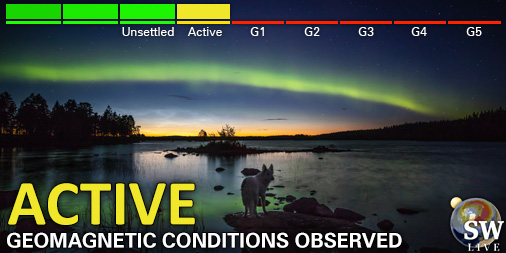Visualizzazione archivio di venerdì, 28 marzo AM
Daily bulletin on solar and geomagnetic activity from the SIDC
Emesso: 2025 Mar 28 1244 UTC
SIDC Forecast
Brillamenti solari
C-class flares expected, (probability >=50%)
Geomagnetism
Minor storm expected (A>=30 or K=5)
Protoni solari
Quiet
| 10cm flux | Ap | |
|---|---|---|
| 28 Mar 2025 | 156 | 019 |
| 29 Mar 2025 | 155 | 039 |
| 30 Mar 2025 | 153 | 025 |
Solar Active Regions and flaring
Solar flaring activity was low over the past 24 hours, with only C-class flares identified. The largest flare was a C8.8 flare (SIDC Flare 3926) peaking at 22:24 UTC on March 27, which was produced by SIDC Sunspot Group 455 (NOAA Active Region 4043). During the flare, the source region (SIDC 455) of the flare had beta configuration of its photospheric magnetic field. A total of 5 numbered sunspot groups were identified on the disk over the past 24 hours. Presently, four sunspot groups (SIDC Sunspot Groups 4035, 4041, 4043, and 4044) have beta magnetic configurations. The solar flaring activity is expected to be at low to moderate levels over the next 24 hours with C-class flares expected, M-class flares probable, and a small chance of X-class flares.
Espulsioni di massa coronale
No Earth-directed coronal mass ejections were detected in the available coronagraph observations during last 24 hours.
Fori coronali
All three positive polarity SIDC Coronal Holes 60, 82, and 96 have crossed the central meridian. These coronal holes are the extension of southern polar coronal hole extending all across the solar equator. The high speed streams originating from these coronal holes are expected to impact the Earth until Mar 30.
Vento solare
Earth is still under the influence of fast solar wind. The solar wind speed ranged from 580 km/s to 840 km/s. The interplanetary magnetic field ranged from 2 nT to 9 nT, and the North-South component (Bz) ranged from -8 nT to 8 nT. In the next 24 hours, enhanced solar wind conditions are expected to continue with the continuous arrival of high speed streams from the positive polarity coronal holes (SIDC Coronal Holes 60, 82, and 96) which are the extension of southern polar coronal hole extending all across the solar equator.
Geomagnetism
Geomagnetic conditions were globally at quiet to minor storm conditions (NOAA Kp 2 to 5), and locally at quiet to active conditions (K_BEL 2 to 4) during the past 24 hours. The disturbed geomagnetic conditions was due to the arrival of high speed streams (HSSs) from the SIDC Coronal Hole 60, 82, and 96. In the next 24 hours, active to moderate storm conditions (K 4 to 6) are possible with the continuous arrival of HSSs from three, positive polarity coronal holes which are the extension of southern polar coronal hole extending all across the solar equator.
Proton flux levels
The greater than 10 MeV GOES proton flux remained below the threshold level over the past 24 hours and is expected to remain so for the next 24 hours.
Electron fluxes at geostationary orbit
The greater than 2 MeV electron flux, as measured by GOES-16 satellite, remained below the 1000 pfu threshold level over the past 24 hours. The greater than 2 MeV electron flux, as measured by GOES-18 satellite, mostly remained below the threshold level, except from 21:00 UTC on Mar 27 to 00:15 UTC on Mar 28, when it fluctuated around the threshold level. In the next 24 hours, the electron flux is expected to remain below the threshold level, but increasing above the threshold level cannot be excluded. The 24h electron fluence is presently at normal level, and it is expected to remain so in the next 24 hours.
Today's estimated international sunspot number (ISN): 078, based on 12 stations.Solar indices for 27 Mar 2025
| Wolf number Catania | 129 |
| 10cm solar flux | 153 |
| AK Chambon La Forêt | 038 |
| AK Wingst | 026 |
| Estimated Ap | 029 |
| Estimated international sunspot number | 082 - Based on 27 stations |
Noticeable events summary
| Day | Begin | Max | Fine | Loc | Strength | OP | 10cm | Catania/NOAA | Radio burst types | |
|---|---|---|---|---|---|---|---|---|---|---|
| Nessuna | ||||||||||
Provided by the Solar Influences Data analysis Center© - SIDC - Processed by SpaceWeatherLive
Tutti gli orari in UTC
<< Vai alla pagina della panoramica giornaliera
I dati attuali suggeriscono ci sia una lieve possibilità perché l'aurora compaia alle seguenti regioni ad alta altitudine nel futuro prossimo
Yellowknife, NTUltime notizie
Ultimi messaggi dal forum
Supporta SpaceWeatherLive.com!
Molte persone vengono su SpaceWeatherLive per seguire l'attività del Sole o sapere se ci sia la possibilità di vedere l'aurora, ma a maggior traffico corrispondono costi maggiori. Considerate una donazione se vi piace SpaceWeatherLive così che possiamo mantenere online il sito web!

Ultimi avvisi
04:15 UTC - Attività geomagnetica
Condizioni geomagnetiche attive (Kp4) Soglia Raggiunta: 03:57 UTC
02:30 UTC - Indice di potenza emisferica
Il modello OVATION prevede che l'indice di potenza emisferica raggiunga i 50GW alle 03:23 UTC
mercoledì, 16 aprile PM
21:45 UTC - Attività geomagnetica
Tempesta geomagnetica G1 minore (Kp5) Soglia Raggiunta: 21:36 UTC
21:00 UTC - Attività geomagnetica
Tempesta geomagnetica G1 grave (Kp5) Soglia Raggiunta: 20:55 UTC
19:45 UTC - Attività geomagnetica
Tempesta geomagnetica G1 forte (Kp5) Soglia Raggiunta: 19:25 UTC
Notizie sul meteo spaziale
| Ultimo brillamento X | 2025/03/28 | X1.1 |
| Ultimo brillamento M | 2025/04/15 | M1.2 |
| Ultima tempesta geomagnetica | 2025/04/16 | Kp8- (G4) |
| Giorni senza macchie | |
|---|---|
| Ultimo giorno senza macchie | 2022/06/08 |
| Media mensile Numero di Macchie Solari | |
|---|---|
| marzo 2025 | 134.2 -20.4 |
| aprile 2025 | 120.5 -13.7 |
| Ultimi 30 giorni | 118.3 -22.1 |






